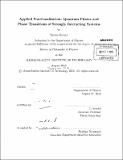Applied fractionalization : quantum phases and phase transitions of strongly interacting systems
Author(s)
Grover, Tarun, Ph. D. Massachusetts Institute of Technology
DownloadFull printable version (8.261Mb)
Other Contributors
Massachusetts Institute of Technology. Dept. of Physics.
Advisor
T. Senthil.
Terms of use
Metadata
Show full item recordAbstract
Strongly correlated systems present interesting challenges in condensed matter physics. On the one hand, the theoretical work in the last two decades suggests that strong interactions may lead to new phases and phase transitions of matter that don't fit paradigms such as Fermi liquid theory or Landau's theory of phase transitions. On the other hand, there are actual materials which are undoubtedly governed by strong interactions and indeed do not fit the conventional paradigms but whose behavior often doesn't quite match our theoretical expectations. This gap between theory and experiments is slowly narrowing owing to the discovery of new materials and recent advances in numerical simulations. As an example, the material K - (ET)2Cu 2(CN) 3 exhibits metallic specific heat in its insulating phase. This is indicative of the theoretically proposed phenomena of 'fractionalization' where elementary excitations in a phase carry quantum numbers that are fractions of that corresponding to an electron. Similarly, there is growing numerical evidence of the theoretical phenomena of 'deconfined quantum criticality', where quantum Berry phases lead to emergence of fractionalized particles right at the phase transition. In this thesis we study phenomena where the concept of fractionalization is a useful tool to explore new phases and phase transitions. Most of our examples are in the context of frustrated quantum magnets. Along the way, we also explore topics such as quantum numbers of topological defects and non-abelian phases of matter. Whenever possible, we compare theoretical predictions with experimental and numerical data. We also discuss deconfined quantum criticality in the context of metallic systems where it opens the route to phase transitions very different from the conventional spin-density wave instability of Fermi surface.
Description
Thesis (Ph. D.)--Massachusetts Institute of Technology, Dept. of Physics, 2010. Cataloged from PDF version of thesis. Includes bibliographical references (p. 131-136).
Date issued
2010Department
Massachusetts Institute of Technology. Department of PhysicsPublisher
Massachusetts Institute of Technology
Keywords
Physics.